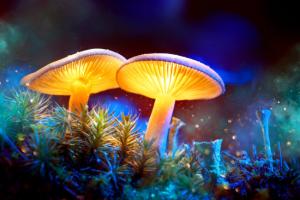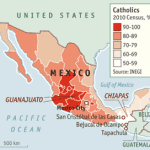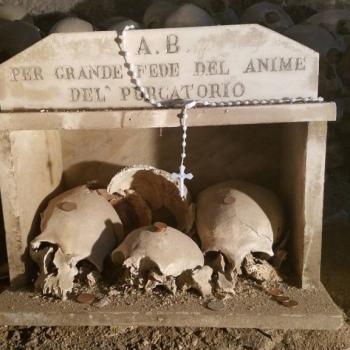
By guest contributor Dr. Robert Chesnut*
I was working on my divinity degree at Harvard in the early 1960s when stories began to circulate about LSD experiments being conducted in the university’s psychology department. Under the direction of professors Timothy Leary and Richard Alpert, some of my fellow theological students and a group of prison inmates were rumored to be among the experiments’ subjects. Transcendental spiritual experiences and the rehabilitation of hardened criminals were said to be among the early results.
In 1962, Harvard theological Ph.D. student Walter Pahnke conducted his now famous Boston University Marsh Chapel experiment. With twenty divinity students as subjects, Pahnke administered psilocybin (magic mushrooms) to one half of the group and a placebo to the others. Almost all those who received psilocybin reported profound mystical experiences. One of those subjects was the renowned scholar of world religions Houston Smith who would later describe his experience as “the most powerful cosmic homecoming I have ever experienced.”
In his widely acclaimed New York Times best-seller, How to Change Your Mind (2018), Michael Pollan reviews this history of experimentation which soon came to a screeching halt. Reports of abuses and excesses ended the academic careers of Leary and Alpert. As the two men then became popularizers of “turning on, tuning in, and dropping out,” psychedelics were soon perceived as a threat to social stability, blamed for encouraging countercultural resistance to war, free love, draft-card burning, and general dissipation among the nation’s youth. Richard Nixon called Leary “the most dangerous man in America.” In 1968 the U.S. federal government banned all psychedelic drugs, branding them in 1970 with the most restrictively regulated drug schedule of the United States Controlled Substances Act (Schedule I). Experiments ended and valuable research stretching back into the 1940s was soon forgotten and dust-covered.
According to the journal Neuropharmacology, it is now widely recognized that “stigmatization more than actual risks led to research-impeded regulatory control.” During the 1990s and early 2000s, as legal restrictions loosened, research efforts were renewed at such prestigious universities as Johns Hopkins, UCLA, and NYU. Clinical results have been encouraging. “Accumulated research to date suggests psychedelic drug assisted psychotherapy may emerge as a potential breakthrough treatment for several types of mental illnesses including depression, anxiety, post-traumatic stress disorder, and addiction that are refractory to current evidenced based therapies” (Neuropharmacology, 11/2018).
In How to Change Your Mind, Pollan reports extensively on the mystical nature of his own and other subjects’ psychedelic experiences–a key ingredient, it seems, in the salutary therapeutic results being attained in treating mental illnesses, addictions, and the anxiety accompanying terminal illnesses. Bringing to mind Rudolph Otto’s term mysterium tremendum in his 1917 book The Idea of the Holy, Pollan offers riveting accounts of altered states of consciousness that are both awesome and awful, hallowing and harrowing.
Otto describes what he terms “numinous” experiences as encounters with a mystery that is at once “terrifying and fascinating.” Likewise, many of the psychedelic “trips” that Pollan recounts exhibit these same characteristics. This is why, time and again, Pollan stresses the importance of having a carefully controlled setting together with a trained, experienced, professional guide to prepare the way when one embarks on such an adventure. (casual, unguided use is still illegal and potentially harmful). Guides will remain close at hand throughout the experience and then assist with debriefing and integration afterward. Typically, guides will caution subjects in advance that they may encounter terrors. Regarding possible frightening encounters, the guides counsel: Stand your ground. Do not flee in fear. Ask whatever threatens you, “Why are you here? What do you have to teach me?” Here one is reminded how often the same reassurance is offered throughout the Bible. In numinous encounters or when face-to-face with earthly enemies, the faithful hear from God, or prophet, or angels, or Jesus walking on water, or the risen Christ: “Do not be afraid.” Seventy-eight times these words occur in the Hebrew and Christian scriptures!
While psychedelic experiences in Pollan’s account differ widely from subject to subject, the fearsome aspect seems to involve two primary threats. One is a reencounter with past traumas. What can often lie on the other side of facing this fear is a healing resolution of past psychic pain. The second, perhaps even more common threat is the fear of death, the dissolution of the self, the horror of annihilation, the extinction of the ego. What typically lies on the other side of this threat is a mystical experience of an immensely expanded cosmic consciousness, connectedness with all being, loving union with all souls and nature, sublime beauty, compassion, bliss, joy, and an indelible, lasting conviction that one has experienced ultimate reality. One subject described it as being “bathed in the love of God.”
Much of this will sound very familiar to anyone acquainted with the traditional Christian concept and ritual practice known as “the Paschal Mystery.” Centered on the believer’s union with Christ in his death, burial, and resurrection, the mystery is spiritually and ritually re-lived on Good Friday, Holy Saturday, and in the Easter Vigil. While Paul himself does not use the term “Paschal Mystery” (there is one reference to Christ as our paschal [Passover] lamb in I Cor. 5:), the Pauline epistles do provide theological grounding for this experience. In Philippians 2:4-11 Paul depicts the original sacred journey or trip that Christ took for our salvation as a kenosis, a self-emptying that entailed a descent into dark, ignominious suffering and painful death. But then, on the other side, there follow his resurrection and ascent into glorious union with God. At the very beginning of this account in Philippians, Paul appeals to his readers to share in God’s Spirit of love, compassion, and joy. You should Have, he says, “the same mind in you that you have in Christ Jesus,” that is, a mind of self-emptying, self-relinquishment, self-offering love.
For Paul, this same sacred journey is undertaken in the sacrament of baptism, the rite of initiation into the Christian life, traditionally performed as part of the Easter Vigil liturgy. Baptism by immersion is a symbolic death, burial, and resurrection with Christ and in Christ (Rom. 6:3-11). It is a plunge into deep, dark water, undergoing the death of an old self, followed by the birth of a new self. This is the death of a self-centered self and the rebirth of a new self that is recentered in the love of God and neighbor. Baptism is simultaneously an immersion into koinonia or communion in Christ, into Christ’s saving path, and into Christ’s mystical body the church. Time and time again, Paul testifies to the believer as being in Christ and Christ being within the believer. “How great,” he exclaims, “are the riches of the glory of this mystery, which is Christ in you, the hope of glory” (Col.1:27)
Baptism initiates one onto a path of transformation so that “if anyone is in Christ, there is a new creation . . . everything has become new!” (II Cor. 5:17) The ethical implications are profound. Believers have died to sin and are now alive in a way that displays what Paul calls “the fruit of the Spirit”—”love, joy, peace, patience, kindness, generosity, faithfulness, gentleness, and self-control.” (Gal. 5:22)
Those who have had a psychedelic mystical experience also recount transformations that redirected their lives, making them more loving, compassionate, attuned to living in the moment, present to others and to the world of nature. In a twenty-five- year follow-up on the Marsh Chapel experiment, all but one of the subjects who were given psilocybin agreed that they had had an experience of “a genuine mystical nature,” characterizing it as “one of the high points of their spiritual life.” It is also noteworthy that all of the theological students who received psilocybin in the Marsh Chapel experiment became ordained ministers, whereas none did who received the placebo.
In both the Pollan accounts and the Pauline paradigm, there is a transformation rather than an extinction of the self. Yes, under the influence of psychedelics the ego does indeed seem to dissolve or merge into a cosmic unity, yet there nevertheless remains a somewhat distinct self that can observe, remember and integrate it all afterward. Likewise, in Pauline mysticism one might say that the egoistic ego dies, though the self is reborn, transformed. Or, we could say that the “false self” dies, but the “true self” comes to life. There is in Paul no extinction or annihilation of the self. Rather, as Jesus put it, those who lose their life will find their life. The self is both “lost and found” in love, love of God, of neighbor, of and one’s own true and best self.
Pollan acknowledges that psychedelics are not the only route to such experiences. Numinous encounters may occur spontaneously, just as this writer himself experienced at age fifteen when, under a starry night sky, a sudden “showering of God’s love” became a life-transforming moment. We recall Paul’s own “road to Damascus” encounter with the risen Christ. (Acts 9:3-5) Breathing exercises and meditation may also offer paths to altered states of consciousness. Pollan notes that the brain scans of nuns who practice regular meditation are remarkably similar to those who experience psychedelic mysticism. From my own admittedly limited experience of meditation I can testify that it may offer enhanced fruits of the Spirit, stimulate creative imagination, and engender the ability to see promising new connections and possibilities.
Do such mystical experiences correspond to what is “really real,” a conviction reported again and again by Pollan’s subjects? Very likely the best, and maybe the only possible answer comes from Jesus. When John the Baptist was arrested and imprisoned by Herod, John began to doubt whether Jesus and his ministry were the real thing. So, he sent disciples to ask whether or not Jesus was truly the promised one, or if they should “look for another.” Jesus replied, “Go and tell John what you have seen and heard. The blind receive their sight, the lame walk, the lepers are cleansed, the deaf hear, the dead are raised.” (Luke 7:18-22; Matt 11:2-5) Likewise, Jesus said that the test of his true disciples was this: “You will know them by their fruits.” (Matt. 7:16 & 20) As to the “really real” question about the psychedelic mystical experiences reported by Pollan and those encountered by other paths, one can only say that the empirical results point to transformed lives, from death to resurrection–deliverance from addictions, from dark depression and crippling fears of death, the healing of past traumas, increased capacity for loving and living in the moment, peace and new-found purpose in living.
*The Rev. Robert A. Chesnut, Ph.D., resides in Richmond, VA with his wife Janet. A retired Presbyterian minister, he has held pastorates in Cincinnati, Boston, Chicago, Norman, OK, and Pittsburgh and has taught at McCormick, Garrett Evangelical, and Pittsburgh theological seminaries. He holds the M.Div, and Ph.D. from Harvard and is the author of Transforming the Mainline Church: Lessons in Change from Pittsburgh’s Cathedral of Hope and Meeting Jesus the Christ Again: A Conservative Progressive Faith.













